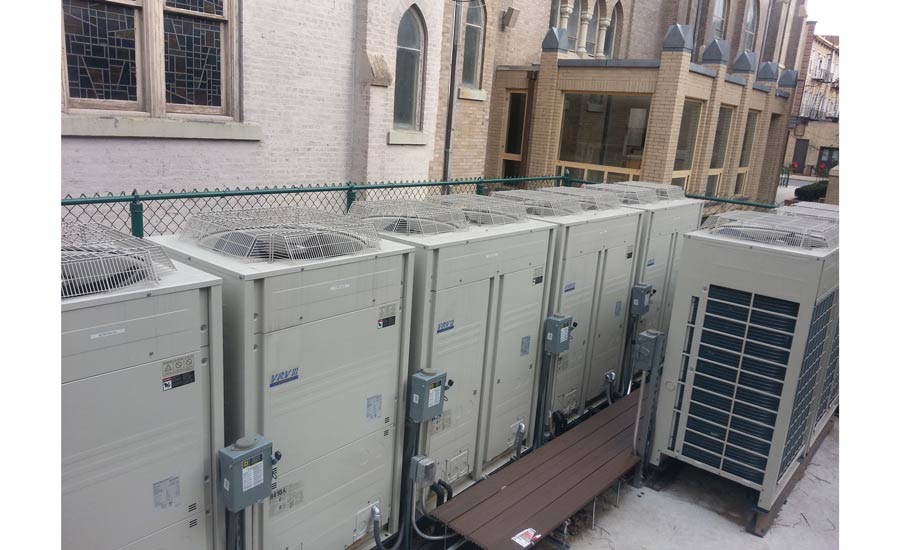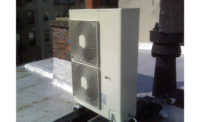The rooftops and backyards of America are changing. Both commercial facilities and residential domiciles are taking advantage of heating and cooling technology at accelerated rates, and these rates are extending to the global market as well. According to a study done by Markets and Markets Research Private Ltd., the HVAC system market size is expected to reach $251.6 billion by 2023. There is an increasing demand for HVAC systems that reduce energy consumption globally, and there is a growing awareness of effective installation of HVAC systems that is driving growth in the Asia Pacific region, the abstract stated.
It is in this marketplace that VRF technology is carving out new paths for contractors, especially in the U.S., where increased awareness and training open up the HVAC market for both professional contractors and their customers.
DESIGN INTEGRATION CHANGES
As professional contractors, a primary source for correct information about equipment installations and improvements is the manufacturers. This rings true for VRF equipment, and much of its improvement information is disseminated through training.
“Training and staying up to date on current technology is imperative for today’s HVAC professional,” said Kevin McNamara, senior vice president and business leader, LG Air Conditioning Technologies. “Building design and construction is a more collaborative effort than ever before. Industry professionals must become experts on the full scope of building ecosystems along with how they relate to the selected HVAC systems. Training will only help to this end. Gaining hands-on training of the technology enables professionals to better meet and understand the needs of their customers.”
One aspect of this training focuses contractors on advanced software and controls. According to Matt Wall, senior product marketing manager, Samsung HVAC, VRF integrated controls make service software a requirement for the proper installation and maintenance of VRF equipment.
“VRF now requires a commissioning agent or a service technician to use a laptop in order to start up a VRF system or efficiently service the system,” he explained. “VRF systems operate differently than other unitary products. HVAC technicians are having to take higher educational classes from VRF manufacturers to learn how to properly diagnose and troubleshoot equipment.”
These enhanced controls and software systems, however, can be a double-edged sword for VRF. Although technicians will require further specialized training, the enhancements also provide an increased flexibility in controls and options.
“Engineers are specifying a wide range of controls with device interlocking, and today’s contractor needs to be able to seamlessly integrate VRF systems into a wide range of control platforms and to easily interlock with other devices,” said Wall.
This skill will not only come in handy for the advanced technology being integrated with HVAC systems in general, but it will also help contractors that are finding success with integrating VRF systems with existing mechanical systems. This shift is helping move VRF from a standard design and installation to a customization of building comfort that fits the needs of each type of application.
“The ability to tailor a solution to the specific needs of an application, along with energy efficiency, quiet operation, and design flexibility, have contributed to the growth in VRF adoption, as mechanical engineers in the U.S. have been increasingly involved in VRF installation in the past three years,” said McNamara. “This type of large-scale acceptance allows for broader application across residential, light commercial, and commercial projects of all types.”
VRF DEMAND
Both commercial and residential customers are driving demand for VRF installations due not only to their energy savings and customization but also their improved aesthetics and unique interfaces.
“More restaurants and retail shops are moving to open type ceilings, and some building owners do not want to see indoor units or ductwork hanging,” said Wall. “The stylish design of Samsung’s cassette units can help contractors fill this need, and it also provides easier and cleaner looking installations for the contractor.”
Designed for commercial use, the Samsung cassette units with Wind-Free™ technology provide cooling to the space without blowing directly onto the occupants. Their air current to the space is under 0.15 m/s while in Wind-Free™ mode. Air velocity that is below 0.15 m/s is considered “still air” as defined by ASHRAE. The cassette panel has thousands of micro-holes through which air is diffused.
Along with aesthetics, manufacturers are starting to see an increased trend in expectations for unique interfaces such as voice command and proximity technology. Although these technologies may sound like prime additions to residential applications, the fact is that these demands are creeping into the commercial market.
“Users are expecting more personalized HVAC experiences in commercial settings,” said Malcolm Persaud, national sales and product manager, Panasonic. “For the HVAC technician, it’s important to understand how these trends help reduce operating costs and productivity for facility managers as well as increase satisfaction from end users. Where technologies are constantly enhancing, it’s important for HVAC technicians to stay up to speed with integration options and work with a manufacturer that can collaboratively offer suggestions for projects.”
WATCH THE HORIZON
If there were a drinking game for future trends in HVAC, increased cloud computing would likely be one of the key phrases. The term applies to a broad technology offering that includes VRF.
“Cloud computing’s ability to better learn the operating parameters of each system to then fine tune its operation, location by location, will produce optimized operation and increased unit failure prevention capabilities,” said Wall.
Another future key term is sustainability. Perhaps too broad to be summed into one word, sustainability explores topics like decarbonization and net-zero homes.
“This focus on sustainability will lead to broader adoption of passive building designs and net-zero homes,” said McNamara. “There will be more integrated products as well to reduce energy consumption in homes and buildings as utilities look for new ways to address delivery and consumption challenges. The future for HVAC contractors is bright, especially if they are willing to challenge their current business model and think on a broader scale for where the business is heading.”
Persaud’s key word, comfort, will likely push VRF equipment beyond temperature.
“I think we’ll see HVAC comfort redefined in the industry to also include the right humidity level, limiting drafts, increasing purification elements, and easy installation and servicing,” he said. “Be knowledgeable of the multitude of comfort elements in VRF in addition to temperature comfort that are advantageous for both owners and end users.”
He advised contractors to look for manufacturers that offer free training to deliver the right comfort for different users.
“We realize that a system is only as good as its installation,” added Persaud. “We take pride in our training program and our highly trained team for helping technicians with projects.”
See more articles from this issue here!





